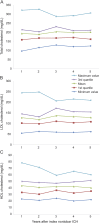APOE ε4 and lipid levels affect risk of recurrent nonlobar intracerebral hemorrhage
- PMID: 26115730
- PMCID: PMC4520812
- DOI: 10.1212/WNL.0000000000001790
APOE ε4 and lipid levels affect risk of recurrent nonlobar intracerebral hemorrhage
Abstract
Objective: Genetic variants ε2/ε4 within the APOE gene are established risk factors for lobar intracerebral hemorrhage (ICH). Published preliminary data suggest a potential role for APOE ε4 in risk of nonlobar ICH. We therefore investigated the role of APOE in recurrent nonlobar ICH, and sought to clarify whether effects of APOE on circulating lipids mediate this association.
Methods: Three hundred sixty-three survivors of nonlobar ICH were followed prospectively for ICH recurrence, with APOE genotype determined at enrollment. All participants had clinical, demographic, and laboratory data captured at time of index ICH and during follow-up. Using a multivariate model, we performed association and interaction analyses of the relationships among APOE genotype, lipid levels, and recurrent nonlobar ICH.
Results: We observed 29 nonlobar ICH recurrences among 363 survivors. APOE ε4 was associated with recurrent nonlobar ICH (hazard ratio = 1.31; 95% confidence interval = 1.02-2.69; p = 0.038) after adjustment for age/sex/ethnicity and cardiovascular risk factors. Increasing low-density lipoprotein (LDL) levels were associated with decreased risk of recurrent nonlobar ICH (p = 0.027), as were decreasing HDL levels (p = 0.046). LDL levels modified the association of APOE ε4 with recurrent nonlobar ICH (mediation p < 0.05). No associations were identified between APOE ε2 and recurrent nonlobar ICH.
Conclusion: APOE ε4 is associated with recurrent ICH in nonlobar brain regions, providing further evidence for its causal role in ICH unrelated to cerebral amyloid angiopathy. LDL levels modulated this effect, suggesting that circulating lipid levels may mediate a portion of the role of APOE ε4 in nonlobar ICH.
© 2015 American Academy of Neurology.
Figures




References
-
- Krishnamurthi RV, Moran AE, Forouzanfar MH, et al. The global burden of hemorrhagic stroke: a summary of findings from the GBD 2010 study. Glob Heart 2014;9:101–106. - PubMed
-
- Poon MT, Fonville AF, Al-Shahi Salman R. Long-term prognosis after intracerebral haemorrhage: systematic review and meta-analysis. J Neurol Neurosurg Psychiatry 2014;85:660–667. - PubMed
-
- Weimar C, Benemann J, Terborg C, et al. Recurrent stroke after lobar and deep intracerebral hemorrhage: a hospital-based cohort study. Cerebrovasc Dis 2011;32:283–288. - PubMed
Publication types
MeSH terms
Substances
Grants and funding
- P30 AG062421/AG/NIA NIH HHS/United States
- U10NS077360/NS/NINDS NIH HHS/United States
- U01 NS069208/NS/NINDS NIH HHS/United States
- R01 NS059727/NS/NINDS NIH HHS/United States
- R01 NS073344/NS/NINDS NIH HHS/United States
- R01NS073344/NS/NINDS NIH HHS/United States
- U01NS069208/NS/NINDS NIH HHS/United States
- AG26484/AG/NIA NIH HHS/United States
- K23 086873/PHS HHS/United States
- R01 AG026484/AG/NIA NIH HHS/United States
- K23 NS086873/NS/NINDS NIH HHS/United States
- P50 AG005134/AG/NIA NIH HHS/United States
- P50 NS051343/NS/NINDS NIH HHS/United States
- U10 NS077360/NS/NINDS NIH HHS/United States
- R01 NS063925/NS/NINDS NIH HHS/United States
LinkOut - more resources
Full Text Sources
Molecular Biology Databases
Miscellaneous
